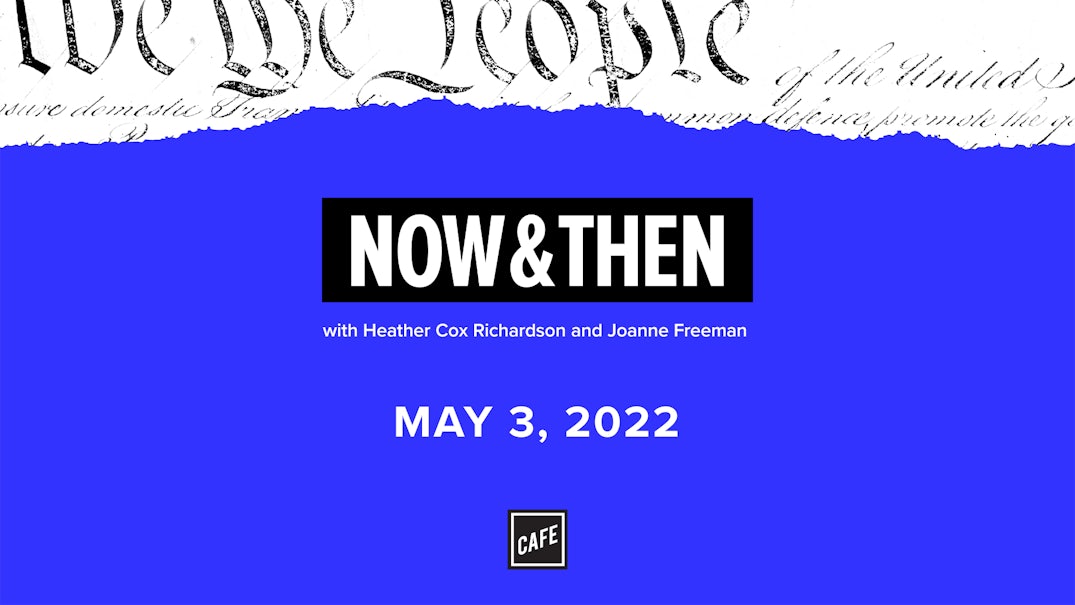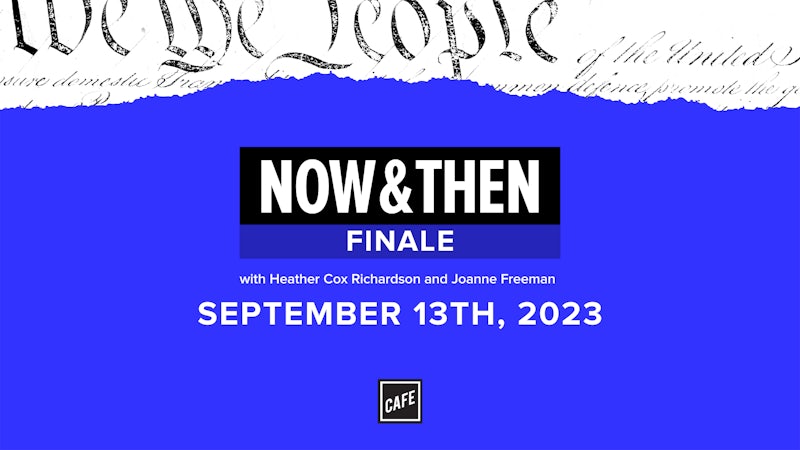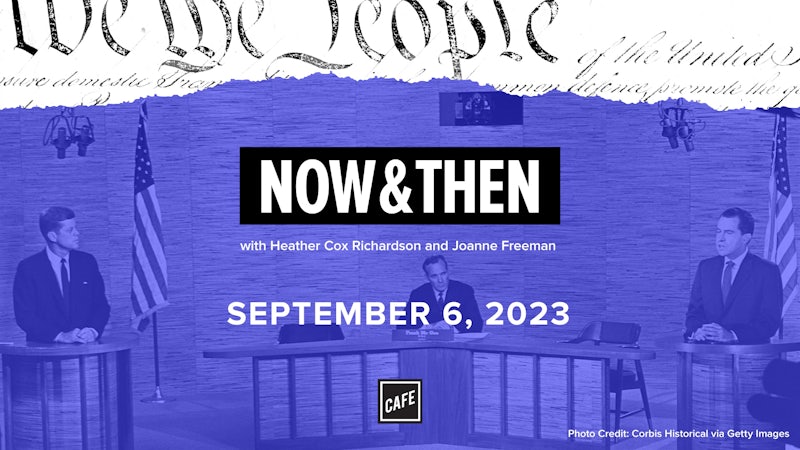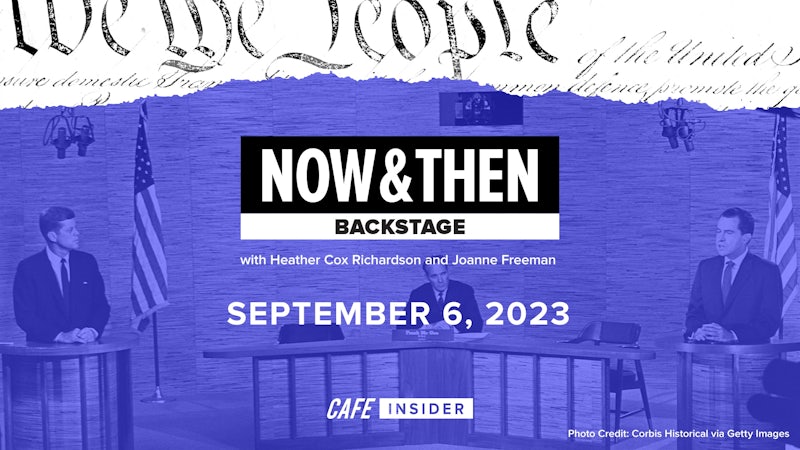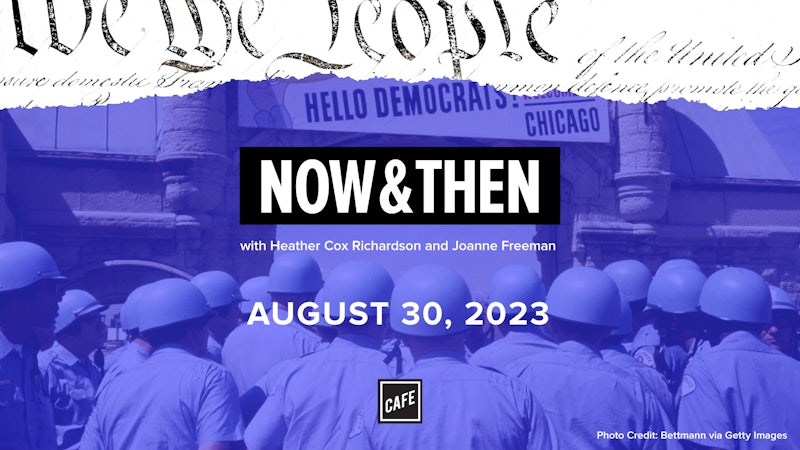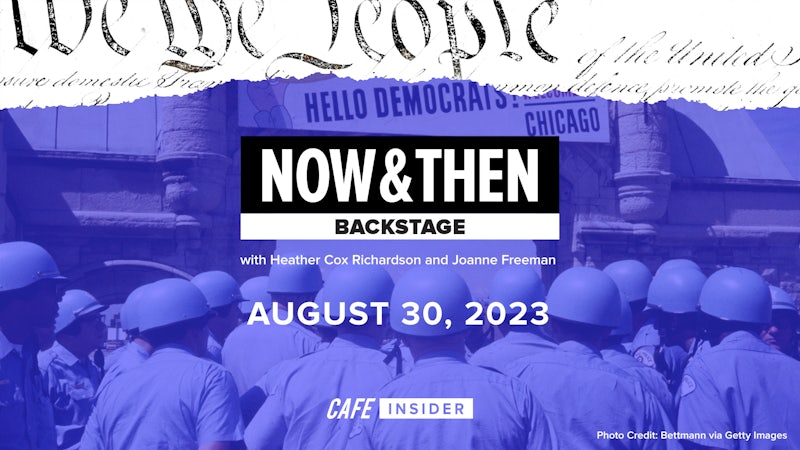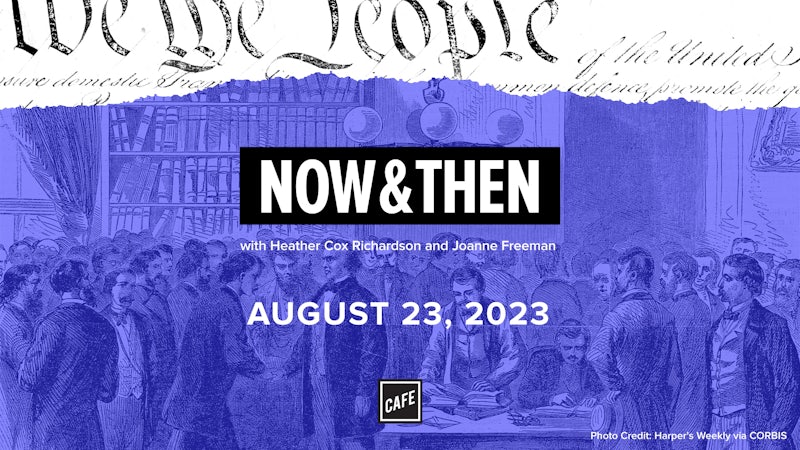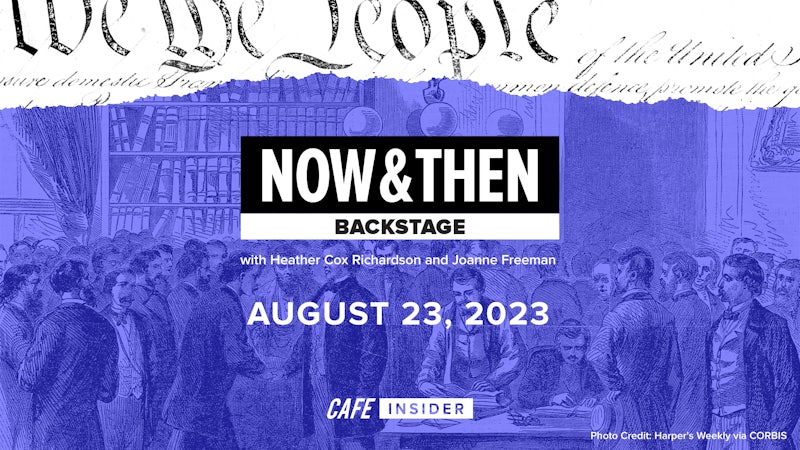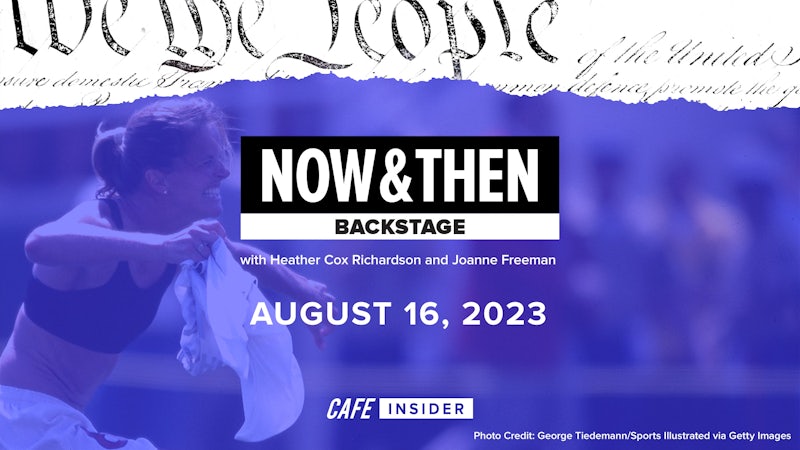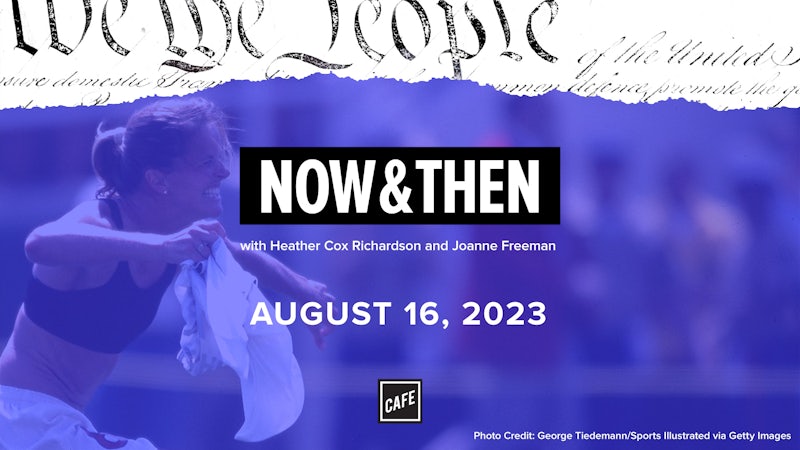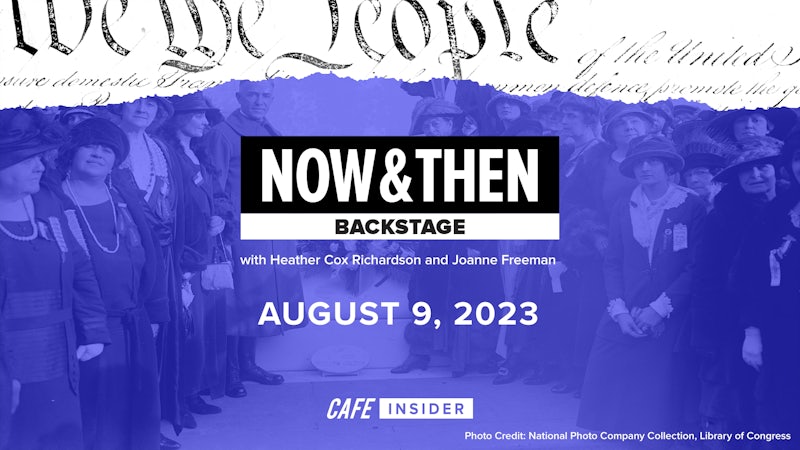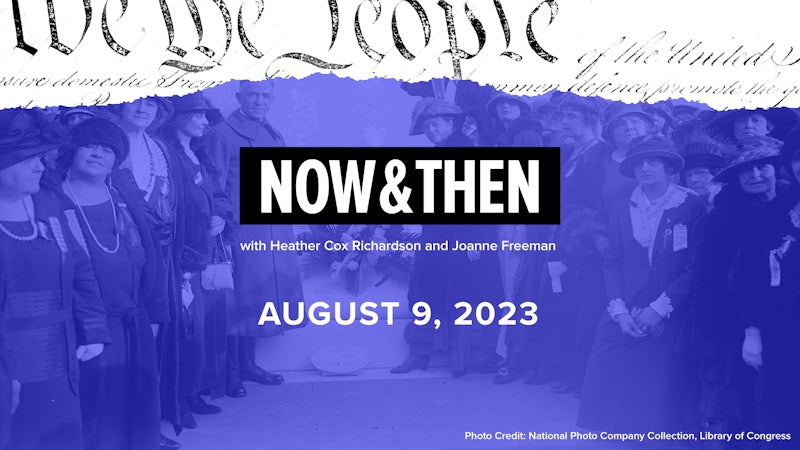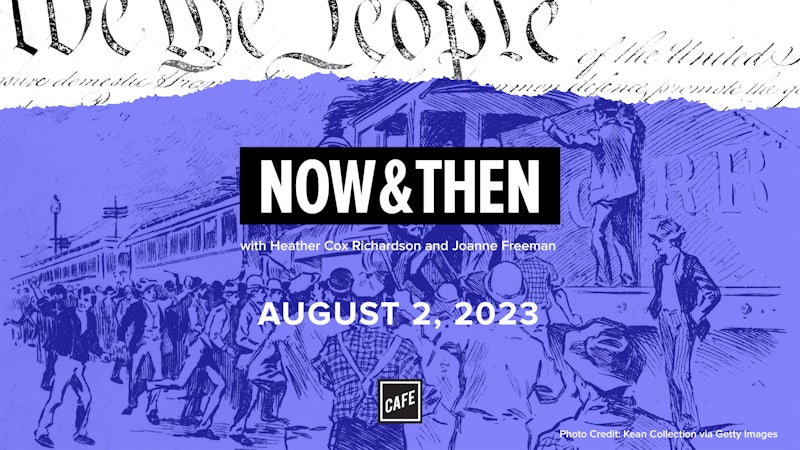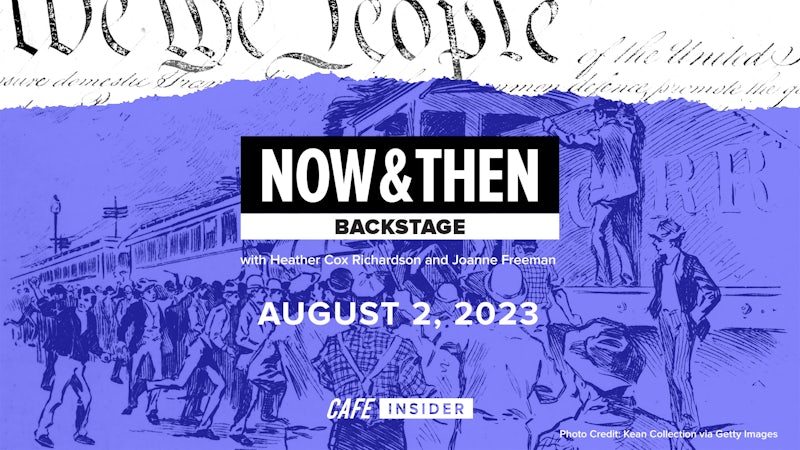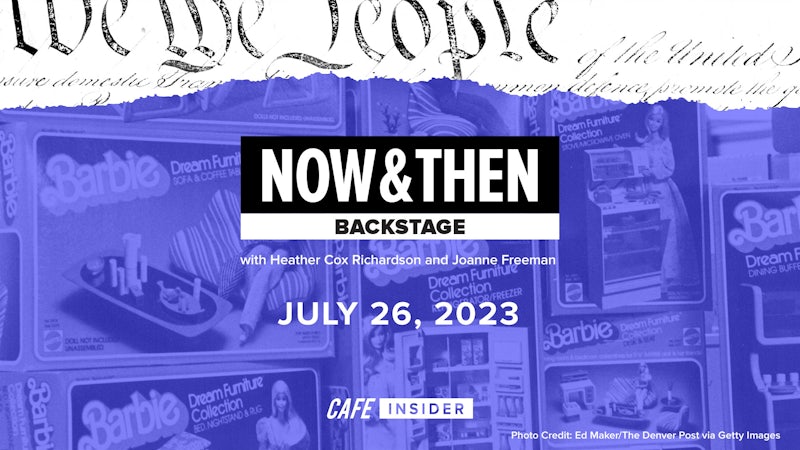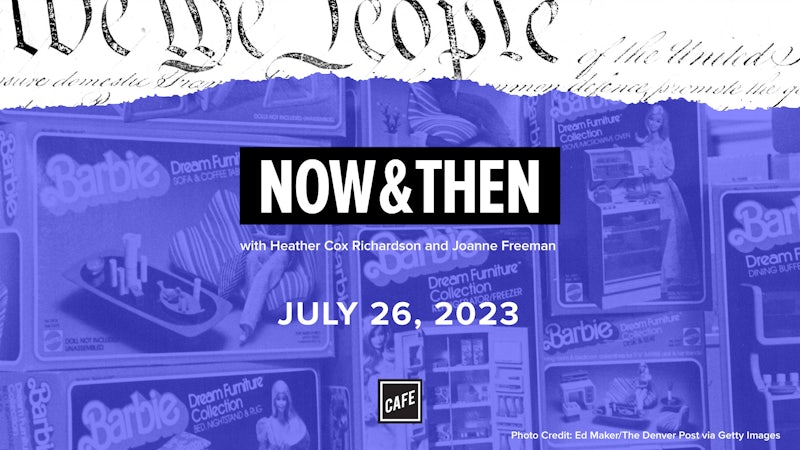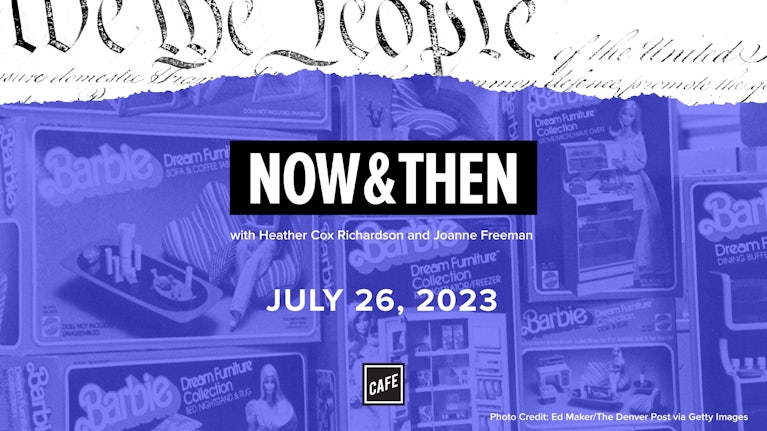Heather Cox Richardson:
From CAFE and the Vox Media Podcast Network, this is Now and Then. I’m Heather Cox Richardson.
Joanne Freeman:
And I’m Joanne Freeman. Today we’re going to be talking about the disability rights movement and more broadly than that. Disability and how the United States in one way or another has been defining and redefining it, and how that has had broader implications. And I will say right off the cuff, the event that launched this is obviously the lifting of the mask mandate. There are all kinds of footage and tweets and everything else of people celebrating, “Yippee, we don’t have to wear masks anymore.” Leaving out entirely the question about anyone with any kind of a disability or preexisting condition was now just being essentially thrown to the wolves, “Whatever you don’t matter anymore, no more masks.”
And I actually saw a tweet that was part of what made me think this was the moment to talk about this. It was by a science journalist named Erin Biba, and she said, “I don’t think ableds have any idea the growing level of seething, frothing, righteous, totally justified rage that is currently brewing in the disability and chronic illness community right now. At some point, hell hath no fury is all I’m saying.” I saw that and I felt that in my gut, that’s a strong statement, and it’s a statement that isn’t just about now.
Another person who commented on it in an interview with ABC News, Maria Town, who’s president, CEO of the American Association of People with Disabilities said, “The fact that we have to just say over and over again, that our lives are worth saving, it’s really soul crushing. There’s a constant questioning of what can we be doing differently? What can we be doing more of? And after two years of having to defend our humanity, it becomes even harder to answer those questions.”
So, it’s the event of the lifting of the mask mandate, the outrage on the part and the justifiable outrage on the part of people with chronic illnesses or who are disabled, and the response, that’s what launched us in this direction today to really get a sense over time of how this question of disability has been reckoned with on the part of disabled Americans and on the part also of the government itself.
Heather Cox Richardson:
And before we get into this topic, let’s just go over some of the statistics. According to 2018 report from the Centers for Disease Control and Prevention, one in four Americans, which is about 61 million Americans have some type of disability, either from diabetes to depression, anxiety to paralysis, and it’s also really important to recognize that although the disability community is quite large and almost all of us will either experience a disability in our lifetimes or have a close friend or family member who does, it encompasses a huge range of experiences.
So more than 7 million adults in the United States, about 3% of them are characterized by health professionals as immunocompromised because of a disease or a medication or another treatment that weakens their body’s immune responses. So we’re talking about a really large, really diverse community of Americans who have always been part of America and how they have been part of this country says a lot about who we are and who we have been. The director of the Disability Justice Initiative at the Center for American Progress, Mia Ives-Rublee, did an interview with the San Diego Union-Tribune and she made a really important point.
And what she talked about in her interview was, she talked about how a lot of people don’t understand the lives of disabled people who are just trying to live their lives in a way that everybody else is, and that they deserve the same chances that everybody else has. She said, “There’s a very paternalistic approach to disability and the belief that individuals with disabilities don’t get out, that they don’t have jobs and that they’re taken care of by family members. That type of mentality means that people don’t see us as whole human beings. So our rights aren’t equal to the rights of everybody else.
One of the things I talk about is that if you have the benefit of being able to age gracefully and get into your sixties and seventies, you’re likely going to have a disability at some point in your life. To understand that disability is just a normal part of the human experience and that they deserve the same approaches to public health and public policy, we’re actually providing support to everybody and every community rather than pushing forward a more individualistic approach that benefits the healthy and the wealthy.” And that hits right to the points that we wanted to get to today about the ubiquity of the disability community in American society and the different ways that they have been used to define America.
Joanne Freeman:
This is a matter that has to do with society, civil society and humanity, who we are as people who others are as people. It’s a sweeping issue, as I think is going to become clear today, as we continue this discussion. Now, it’s worth noting that in early America already, as would not be surprising to say, people were, in some cases, focusing on people who had some kind of a physical disability, particularly when they were trying to enter into a community or a colony from outside, that factor would be noted, and it would be noted particularly because someone who entered a colony or a town or a city with some form of being disabled probably couldn’t support themselves, or that was the assumption at the time.
So there was some general resistance, really more than anything else for people coming into a community rather than community members themselves. Bt where this becomes really interesting and actually really obvious is in the aftermath of the American Revolution.
Heather Cox Richardson:
So the Revolutionary War brings up this crucial question of, what does it mean to fight for this new country? And we get this idea of the citizen soldier who leaves his farm and goes off and fights and comes home. And that’s going to be, I think, a really problematic trope for the rest of American history because people get this idea that you can simply drop your shovel and go out and fight and come back without a recognition that you’re not going to come back the same way as you left, and that’s going to create a real drain on the American economy, and a real question about who gets to be a citizen. But they also in the revolutionary period, start to build up a cultural understanding of disability. Don’t they?
Joanne Freeman:
In the early years of the Republic, so we’re talking about really under the constitution, the United States believes that it is creating a distinctive kind of culture from monarchical culture and all of the pomp and finery of the old world. The assumption is that in a Republic, it’s more grounded on people, the average person, less grounded on aristocrats, and a Republican is cleaner and simpler in style.
A republican, small R, is someone who is just straightforward and isn’t into finery. So what’s interesting is you have someone like the New York politician, Gouverneur Morris, who’s a fascinating character. He’s wonderful to the point that when I teach about him, I refer to him as the Gouv because it just suits him. He’s a really interesting character.
Heather Cox Richardson:
Quite a ladies man too. Is he not?
Joanne Freeman:
Well, no, because he used it as a story. So he lost a leg and he claimed that he lost the leg jumping out of a window when a husband came home and he was with the wife and it was big drama. In fact, he had a carriage accident and lost his leg, and his leg actually, I should say, is at the New York historical society. I think it’s still on display, and apparently it’s one of very few prosthetic devices left over from that time period.
Heather Cox Richardson:
Oh, the prosthetic is there.
Joanne Freeman:
Oh yeah, no, not his-
Heather Cox Richardson:
Oh my God. I’m almost here like, “Who does that?” Okay?
Joanne Freeman:
No, no, no. So what’s interesting about Morris is, again, coming from this, wanting to be like the plain straightforward Republican American, he could have chosen a fancier leg, prosthetic leg. He chooses to have a wooden one. And he sees that as admirably simple and plain and Republican. And he even says, he goes to Europe, he ends up being in France during very peak years of the French Revolution, and he says that he thinks his leg created a sense of what he called Republican equality in the eyes of the French.
He says that, “My first approach, the simplicity of my dress, my wooden leg and tone of Republican equality seemed totally misplaced.” So fascinatingly, Morris is saying that a wooden leg is a very powerful political symbol, and particularly overseas. We’re talking also in some ways about people themselves, people who are disabled in various ways and how they are making their way in society and how they are perceived and how that changes over time. There you have a growing community of people, soldiers, veterans, who are being injured in all sorts of ways in the process of battle and want pensions from the government and that need and desire on their part, perfectly justifiable banging up against the government, having to decide what that means and who qualifies for it.
It ends up leading to a stream of really interesting acts in which you can see the government grappling with what disabled actually means. They’re not necessarily using that word at this point, but they’re trying to figure out what does it mean to be disabled? What kind of person is due to have that kind of support from the government? So a great example of this is that, right off the cuff in the middle of the revolution, the Continental Congress issues a resolution that basically says, “Loss of limb privileges you to some kind of government support.”
So, they’re pretty much tying this as I mentioned a moment ago, to your ability to labor, and they’re assuming here in that kind of a statement that if you have lost a limb you will not be able to labor successfully, and so, you then become someone who is worthy of government support in some way. So that’s 1776, bump up a little in time, 1793, once again, grappling with Revolutionary War pensions. Now, there’s more specific language that’s being built into this Pension Act that says that whatever the disability is and loss of limb is still included, it has to be decisive.
So they’re willing to move things away from just privileging the loss of a limb and having that be the definition of someone who is disabled and worthy of support, a decisive disability. Now they’re still tying this to warfare so that a person who lost a leg not due to warfare would have no reason to get support while someone who did would. In 1806, suddenly you have to have a doctor describe the wounds that you have and testify to what you see, again, to limit and define what does it mean to be someone who is disabled in some way.
The fact that these are happening every few years, again, shows you they have more and more and more people making demands stepping forward as being disabled in some way, and the government has to deal with these people. And you’re watching in this series of acts that government trying to figure this out. Finally, in 1818, they come right out and they move away from, you have to have lost a leg or have a decisive injury, they say that disability is explicitly an inability to perform economically productive labor. So it boils down to, can you work to support yourself? Can you be a working member of a community?
That’s the kind of logic that between the 1820s and the Civil War leads to some states disenfranchising disabled residents, having voting exclusions, because the assumption is, well, if they’re not working to support themselves, if they’re not “fit members of the community,” should they be voting? So you can see right off the cuff in these early years, the ways in which disability, citizenship, community, and the government’s place in all of this is really being wrestled with on an ongoing basis.
Now, it’s interesting to note here that what I just described was the government wrestling with it, But others were just taking advantage of the idea of disability for whatever purpose they wanted to apply it for. And a particularly striking and ugly yet almost unbelievable Example of this took place in a book published in 1848 by Samuel Cartwright, medical doctor. He basically practiced a form of scientific racism, and his book, which is talking about the diseases and physical peculiarities of, I think, he calls it the Negro race, but that’s what he’s focused on. And in the book, he looks at things that, more than anything else, enslaved people are doing.
And if it’s problematic in some way, he declares it a disablement, he declares it a disease. So for example, he says, enslaved people trying to escape, Well, they suffer from drapetomania. They have a disease, they’re disabled, there’s something wrong with them, which the fact that this guy’s going to that length rather than to acknowledge the obvious truth, which is that if you’re enslaved, you want to be free and might try to escape. That’s not part of part Cartwright’s thinking. Or if you are trying to destroy the property of the person who has enslaved you, you are a victim of dysaesthesia aethiopica.
Again, not that you are enslaved and angry, it’s that you are in some way disabled. There’s a problem with you. And along with that, goes the assumption that it’s probably better to keep such people enslaved because they’re disabled, and so they can’t take care of themselves. It’s a really obvious and ugly example of people seizing on that idea, and in this case in a totally, almost nonsensical way, but justifying exclusion, and in this case enslavement.
Heather Cox Richardson:
Well, and that whole period is so interesting for this, because that idea of citizenship early on and its relationship to the Revolutionary War soldiers is the place we get this idea of somebody being a citizen who goes off and fights and then comes home and goes back to being a farmer again, so that there is this sense that you’re not going to get hurt, you’re going to be able to come right back and pick up your farming implements and start being a good American citizen again, and yet what that means is that it creates this weird place where if in fact, you come back with injuries, you’re relying that idea that you can go from being a citizen to being a warrior and coming back to being a citizen.
And it also means it’s expensive. I mean, one of the reasons that the government doesn’t want to start creating the idea that anybody who fights for the country can’t come back and be a farmer again, is because somebody’s then going to have to pay for it. So that idea of, if you can’t fight for the country, if you have some kind of a disability, you shouldn’t be a citizen, you shouldn’t be able to participate in the country. Not only then goes ahead and creates a situation where enslaved people get called disabled because they want to do crazy things like escape, but also women.
I mean, women aren’t going to be good citizens because they too are and they use this word disabled. There’s something wrong with them if they want to participate in the body politic, or if they, for example, want to be equal. That means that there’s no way they can be part of this because they are disabled. That there’s something wrong with them. They’re not the norm, and therefore there’s something separate, and that idea of separating out the people who are differently abled is going to be hugely important for not only disability history going forward, but also for American history.
Because the creation of this concept that somehow disability is different rather than something that we’re all going to go through at some point in our lives or live with in our lives is going to change the way that we think about who gets included. Because you can always say those people, whether they’re Black or female or immigrant, or fill in the blank, you give them a universal disability and say they can’t be with everybody else.
Joanne Freeman:
You create a category.
Heather Cox Richardson:
You create a category.
Joanne Freeman:
Right? You create a category and you put these people in a category and declare it a category. And precisely what you’ve been talking about here, Heather, I mean, we’re all going to, at some point, be in that category. That’s very clearly line drawing often in the case, for reasons of economics, of not wanting to include people because it’s problematic, because it’s expensive, and the category makes no sense.
Heather Cox Richardson:
So that categorization is interesting though, because in the middle of the 19th century, we get this idea of, if you are not able to support yourself in some fashion or your household is not able to support you, you physically need to be removed from society. So, we’ll have the rise of poor farms, for example, with the idea that they’re places where differently able people can support themselves at least to some degree, and they become places where people work on farms, try and produce things for a market where they can make sure they’re not a drag on the public treasury in order to keep them in food and clothing and housing, for example.
But they become merging with the idea of asylums and become warehouses for people who fall into a wide range of categories, of people who need some accommodation. And we’re really focusing today. We ought to say on physical disability, but poor houses and poor farms, and later on institutions will be full of people with mental illnesses or mental disabilities as well. So first of all, you move people off site physically often into the country. Those are going to be your sister who really can’t be cared for at home, or really can’t be integrated into the home economy, and the range of abilities that were on a farm, for example, are going to be really, really wide.
Because of course we don’t have modern medicine, we don’t have the ability to repair injuries. That whole categorization fascinates me in the middle of the 19th century because after the civil war where you’ve suddenly got this enormous influx of people with mental disabilities, for sure, we’re not really going to go there, but physical disabilities creates a new crisis for this idea of who’s going to be welcome or not. Because all of a sudden, you’ve got hundreds of thousands of people who have been disabled by the Civil War, and that is going to do something really interesting in terms of the American economy.
But it’s also going to create the potential crisis of creating a group of Americans who are better than others. That is people who have given their limbs to save the country. There’s an attempt on the part of the government to make sure that disabled veterans don’t become some kind of a special uber citizen because they’ve given this great sacrifice to the nation and they are so many of them, they could in fact become a dangerous political body. For example, like the Grand Army of the Republic, the GAR, which starts to vote pretty heavily for the Republican party and starts to be a swing vote in elections. There’s this idea that “No, no, no, no, no, you’re not extra special because you were disabled in the service of the country, and we want to be very careful not to make a special category for people like you.”
And there too, there’s all that cultural literature about how the men who picked up guns for their country and were injured in the service of their country are special. They’re special hero like Gouverneur Morris, but in this case, these will be poorer men who probably can’t make a living on their own. I also think the political angle of it is really important after the war though, because these are overwhelmingly White men or Black men who would vote the Republican party who are injured. And that means that they have a different claim on the state than, as I said, a farmer who gets kicked by a horse, and that injection of the idea that they might become a favored political class means, for example, the Grover Cleveland vetoes a military pension bill.
Now the military pension bills of the late 19th century are really complicated because they’re so tied up, not only in who’s going to vote for whom, but in the fact that by the 1880s, the Republican party desperately wants to spend money because their tariffs, which protect big business are not necessary for income. And they keep saying, “Oh, we need these for the treasury.” They don’t, they’re running such a high surplus, they’re desperate to spend as much money as they possibly can.
One of the reasons we have all those beautiful buildings and beautiful statues in the 1880s is because they’re like, “Yeah, sure. Let’s put up another statue generally of colonial people or Revolutionary War people.” Because they’re like, “Hey, we’ll spend money.” And that’s part of what’s going on with the dependent pension bills of the 1880s,
But Grover Cleveland, when the Republicans pass one of them, he recognizes that those votes will generally go to Republicans and he vetoes that, and he says, “I cannot believe that the vast peaceful army of union soldiers, who having contentedly resumed their places in the ordinary avocations of life, cherish as sacred the memory of patriotic service, or who having been disabled by the casualties of war justly regard the present pension-roll, on which appear their names, as a roll of honor, desire at this time in the present exigency to be confounded with those who threw such a bill as this are willing to be objects of simple charity and to gain a place upon the pension-roll through alleged dependence.” This conflation here of those disabled people that we’ve pushed off stage versus the ones that we see as virtuous, and surely those who see themselves as virtuous would not want to be considered objects of charity. It’s a wonderful moment where those two things come together.
Joanne Freeman:
They would never want to be associated with that category of person. And that’s fascinating because that one single quote, the division, the categorization there, goes far beyond what we’ve been talking about before. Now, there are different kinds of disabled people. There are the virtuous ones and the ones who are dependent.
Heather Cox Richardson:
Well, but it’s not all that much unlike Gouverneur Morris and the soldiers from the war who can say, “I’m wearing my prosthetic as a sign of my good Americanness.” Versus the guy who’s like, “Dude, I’m starving over here, because I lost my leg in the war, and I can’t farm.” That idea that you can be part of society in some ways, but in other ways, being disabled as a disqualifier for participation in society, if, for example, you’re poor or a person of color or female.
Joanne Freeman:
It’s worth, even just thinking about the language, the rhetoric that’s used to refer to citizenship. The discussion is about people who are fit to be citizens or unfit to be citizens. I mean, there are obviously multiple meanings of the word fit, but there’s a wholeness to it. Can you do what it takes to be a citizen component of it? Physical and I guess even broader than that ideological and social and just that one single quote captures that kind of division, that there are people who, as you keep saying, Heather, fight, come back and are supposed to just go back to their farms and be patriots.
And look at them, they’re fit, they’re fit citizens. They’re fit to be citizens. They’re going to uphold their rights. People who aren’t doing that perhaps are unfit, are a draw on society, are something different entirely. For more CAFE history content, check out Time Machine, a weekly column by our editorial producer, David Kurlander inspired by each Now and Then episode.
Heather Cox Richardson:
You can receive the Time Machine articles through the free CAFE Brief email, sign up at cafe.com/brief. All of the ways that we are talking right now about the relationship of disability to citizenship have an element of patronizing in them. The idea that these are somehow people who consider themselves abled, deciding the role of people they consider to be disabled in society. The 20th century changes that dramatically as physically handicapped Americans begin to demand their inclusion in American society as equals.
And that adds a really different dimension to the discussion of who gets to be in and who gets to be out. That’s going to add a really different view of what it means to be an American citizen. So, one of my favorite groups is the League of the Physically Handicapped, who start in the early 20th century in New York City. And I love this because if you think about the role of disabled Americans in the construction of our country, you can’t not think of Franklin Del Roosevelt who is struck by polio as a young man and confined largely to a wheelchair from then on in his life.
And the fact that his right hand secretary, Missy LeHand also had a chronic illness and died quite young from it, as well as eager as he was to understand the complications of living a life with a physical disability and as eager as he was to make sure that society was welcoming to people with physical disabilities, Missy LeHand was behind him pushing every second being like, “Dude, let’s step this up a little bit here.”
Anyway, theoretically, the New Deal was supposed to treat people with handicaps equally, they were supposed to get jobs and they were supposed to have access to the New Deal programs. But the reality was that’s not the way it played out. So, in New York City, as they are dispersing jobs for new deal programs, the Home Relief Bureau actually stamped applications from physically handicapped people with the letters PH, which stood for physically handicapped, and that was considered unemployable, and they were denied access to the jobs from the works progress administration, and they held a sit-in in 1935 in New York City, and they won, this led to the creation of jobs for physically disabled workers in New York City in 1936.
That idea of physically disabled people stepping up and saying, “Hey, wait a minute here. We’re going to stand up for our rights.” Is crucially important in that era after industrialization has created so many physically handicapped people that suddenly are saying, “Wait a minute here, just because we are no longer able to iron sheets, for example, doesn’t mean that we are somehow not able to participate in American society.”
Joanne Freeman:
Now, this brings us in an interesting way, a little bit more forward in time in the 20th century, what we were just looking at and what you’ve been talking about, Heather, is people with disabilities of various kinds stepping up and expressing their voice and their sense of self and themselves in public spaces to make demands, not surprisingly, what we’re going to see as we move ahead into the 1960s is the growth of what becomes known as a kind of disability rights movement.
And a man who ended up being very influential in this movement is named Ed Roberts. And he was born in 1939 in California, and he and his brothers all contracted polio in 1953. There was a wave of polio beginning in 1952, so he’s part of that wave. His illness worsened to the point that he ended up spending about 18 months in hospitals, often in an iron lung. And when he finally returned home after those 18 months, he was paralyzed from the neck down, and for the rest of his life, he would be confined to a wheelchair and would need to sleep in an 800 pound iron lung and attach a portable respirator and air tube to his wheelchair during the day.
So, he is going to school and completes his coursework at Burlingame High School, and then the school administration refuses his right to graduate citing physical education and driver’s education requirements. When I was reading in preparation for this episode, that one simple fact made me want to punch a desk. He doesn’t qualify to graduate because he didn’t meet physical education and driver’s education requirements. Now his mother, Zona, who was really a lifelong advocate for her son and in a larger sense for disability rights, she petitioned the school board and helped arrange for him to graduate in 1959.
Now, in 1962, after completing an associate’s degree, he applies to UC Berkeley, and is accepted. While he’s there, he sleeps in the college’s hospital, becomes the first ever severely disabled student to matriculate at the college. And during his time there at Berkeley, there are a number of other severely disabled students who are accepted, and they formed ultimately an advocacy group, which they themselves called the Rolling Quads. I think formally it was the physically disabled students program, and they provided free counseling and off campus housing referrals and a wheelchair repair crew.
By 1972, that group had expanded beyond Berkeley and was known as the Center for Independent Living. And because of all of the resources that now were becoming available in Berkeley, the disabled population in Berkeley increased from an estimated 400 in 1972 to 5,000 in 1976.
Heather Cox Richardson:
So as they are advocating for disabled Americans, Congress passes the Rehabilitation Act of 1973. And that is primarily a law that emphasizes the hiring of disabled people on equal basis with abled people. There’s a crucial piece of this and that is called Section 504. And what section 504 does is that it essentially brings forward the Civil Rights Act of 1964 to apply to people with disabilities. And this is a major reworking of the role of people with disabilities in American society, and it runs into a bit of a sticky wicket going forward.
It was supposed to be implemented by the Department of Health, Education, and Welfare, and they keep on saying, “We need different regulations, we need to examine this. We got to figure out how to implement.” And they keep being real slow about moving 504 forward. Roberts doesn’t want any part of how long it’s taking to move 504 forward. He continues to put more and more pressure on the government to implement Section 504. And in 1975, he becomes the director of the California Department of Rehabilitation. Governor Jerry Brown appoints him to that where he continues to advocate for people with disabilities.
So, nothing happens for the next four years. They never really make it through the regulations in part because people are concerned that they are an overreach of the federal government in far, because they’re upset about how much changing accessibility for disabled people is going to cost towns for example, or schools. And finally, they expect that although Nixon and Ford had ignored Section 504, that finally Jimmy Carter would make it happen. And even under Jimmy Carter, the implementation of Section 504 doesn’t move very quickly.
So finally, on April 5th, 1977, Roberts leads a hundred people, many of them with disabilities in a 28 day sit-in protest at San Francisco’s federal offices, that it’s the longest occupation of a federal building in American history. He explained to TV reporters why they were so determined to see the passage of 504. He says-
Ed Roberts (archival):
My ability to regain the pride in myself as a person with a disability is one of the most important things that’s coming out of what’s happening here today, and see hundreds of people with disabilities rolling, signing, using canes, the more severely retarded people for the first time joining us in this incredible struggle is one that leads me to believe that we’re going to win this, that we are not going to stop until 504, which I believe is a basic civil rights platform, the platform that guarantees to each person with a disability in this country, that they are equal in the eyes of the law and that they will have equal access to educational institutions, the hospitals, to the institutions in our society, which serve as all.
Heather Cox Richardson:
And there’s huge support for this, businesses donate supplies, members of the Black Panther Party cook food. The mayor sends in portable showers and sends in mattresses. And finally the protest was successful, 504 is implemented in April of 1977, and they immediately require medical nursing and professional schools to accept individuals with disabilities. New buses had to be accessible for people with disabilities and courthouses had to have ramp access. This is going to be a huge game changer for the disability community in America.
Joanne Freeman:
And I want to make a point here because it’s worth noting that by bringing hundreds of people together and staging that kind of a demonstration, people who were there were in a group and gained a sense of right and identity in that group, and showed that to people by being there in a group. And I just wanted to mention a film, a documentary that I saw a little while back, which I realized captures this process. It’s called Crip Camp. I believe it came out in 2020. It’s a documentary. So it’s true. It’s about a summer camp for people with various disabilities, and these various young people come there.
And in the process of coming together in that camp, gain a real sense of we, of a community and of the fact that they have rights that are not being met, and many of them go on to become really remarkable activists. So some of what we’re looking at here is a group of people who are coming together and teaching themselves something in a way that they didn’t necessarily powerfully have a concrete grasp of yet. And even equally important showing the public that these people are here and that they’re a group and they have demands that deserve to be met.
I mean, we’ve been talking throughout this episode of, in some periods in time in the 19th century, trying to move people who are disabled in one way or another away and out of sight, or seeing them as some unpleasant reminder of warfare. This activism, these demonstrations are really remarkable for the way in which number one, they’re fundamentally changing ideas about disability, and number two, they lead to a rise in disability culture. So for example, there are new magazines that come out in the 1980s like Mainstream or the Disability Rag or an older Accent on Living. All of these things growing out of this moment of the assertion of identity.
Heather Cox Richardson:
That whole idea of being part of a group really helps you to articulate things for yourselves and see yourself be part of a group was absolutely all over the league of the physically handicapped, where one woman actually said, “When we got on that picket line, we felt embarrassed to be seen because of our handicaps, the protest transformed our view of ourselves.” But what you’re talking about in the 1970s, always makes me think of the 1978 film, Coming Home, starring Jane Fonda and Bruce Dern and Jon Voight, because the hero of that film is the Vietnam veteran who has been paralyzed from the waist down by shrapnel to his spine. And he is the romantic hero.
The other Vietnam veteran Jane Fonda’s husband, Bruce Dern is not physically handicapped, but he is the anti-romantic guy. He is not attractive at all. Their sex is terrible. And Jon Voight, who is in a wheelchair is like this incredible romantic lead. And when the Washington Post reviewed that film, the entire film was about how incredibly sexy Jon Voight was in that film, and how this completely upended the whole idea of disabled Americans, as somehow, as you say, being offstage and being somehow not interested in the same things other human beings were because that film very deliberately flipped the script. And that was 1978.
Joanne Freeman:
And it’s interesting because I haven’t thought about that movie in a really long time, and my image of it or my memory of it, which probably comes from advertisements for it is the Jon Voight character in a wheelchair holding Jane Fonda, I think in his lap when there’s a sunset behind them. It’s incredibly romantic image. It’s one of those … He sweeps her off her feet.
Heather Cox Richardson:
Literally, yeah.
Joanne Freeman:
The sun setting behind them. Exactly. So anyway, that is striking, and of course just generally always one of the things that I’m always fascinated by is, when you can look at culture and see in that kind of concrete way, assertions of change in society. And that movie’s a great example. And the fact that there’s grows to be a disability press is another example.
Heather Cox Richardson:
And then Reagan gets elected. Sorry.
Joanne Freeman:
Well, there we are.
Heather Cox Richardson:
And begins to cut the budget, of course, and in those budget cuts are cuts to the accessibility programs that Roberts had worked so hard to orchestrate, and he continues to push, to expand rights for alternatively abled Americans. And he explains why he is upset about Reagan’s budget cuts to journalists in 1981. And he said.
Ed Roberts (archival):
We do care about those folks that are considered the weakest and the government does have a role to play with people who aren’t going to make it without some kind of government help, whether it’s maintenance kinds of help or movement toward independent living. I think constantly reminding people that while we’re in an age of short and a shortage of dollars, that we can’t lose our human values and the values that we’ve built this country on.
Heather Cox Richardson:
So he begins to push for more expanded rights. As he does that, he starts the World Institute on Disability in 1983. He travels around the world to Russia, to Australia, to Japan, and to France to raise public awareness on the idea of independent living for the disabled. He receives a MacArthur Foundation grant in 1984 that funds the institute, and he continues to work at the institute until he dies in 1995 at the age of 56 of a heart attack. But one of the things that he has pushed for so hard is the expansion of disability rights from 504 into a law of their own. And he is going to see that happen on July 26th, 1990 when President George H. W. Bush signed the Americans with Disabilities Act.
Joanne Freeman:
And it is a really overarching piece of legislation that goes beyond Section 504. And I’ll give you a sense here of what is in it. It has very specific and stringent federal accessibility and non-discrimination statutes. That is for a wide range of physical and mental disabilities, deafness, blindness, intellectual disability, partially or completely missing limbs or mobility impairments requiring the use of a wheelchair, autism, cancer, cerebral palsy, diabetes, epilepsy, attention deficit, hyperactivity disorder, HIV infection, multiple sclerosis, muscular dystrophy, major depressive disorder, bipolar disorder, post-traumatic stress disorder, obsessive compulsive disorder, and schizophrenia.
And I will say after that long list, how many of us are included in there in some way? And I will bet a lot of us. So that’s really quite a statement and quite a journey from where we started in this episode.
Heather Cox Richardson:
And President Bush sees that, he gives a speech when he signs it, tying that legislation into other transformative moments in American civil rights history. He says.
George H. W. Bush (archival):
This act is powerful in its simplicity. It will ensure that people with disabilities are given the basic guarantees for which they have worked so long and so hard, independence, freedom of choice, control of their lives, the opportunity to blend fully and equally into the rich mosaic of the American mainstream. And legally, it will provide our disabled community with a powerful expansion of protections and then basic civil rights. It will guarantee fair and just access to the fruits of American life, which we all must be able to enjoy.
Heather Cox Richardson:
So while Ed Roberts is working to call attention to the expansion of the Independent Living Movement, for example, for the disability community, he is not, of course, the only person who’s doing such advocacy work. Patrisha Wright is another great leader who was the co-founder of the Disability Rights Education & Defense Fund. She becomes one of the strongest advocates for the passage of the Americans with Disabilities Act. She helps coordinate a lobbying effort that wins the support of members of Congress, major members of Congress, like Tom Harkin, Ted Kennedy, Bob Dole, and Orrin Hatch, who came together to pass that piece of legislation.
Joanne Freeman:
So that’s quite a journey that we’ve taken over the course of this episode. We landed in a place where it’s very clear that the question of disability is a question of the nature of society, what kind of a society it is. It’s a question about the connection between a people and their government and a people and each other. It’s a question that embraces humanity and a sense of civic society, a sense of a we. It also, we’ve talked about any number of ways in which it involves, of course, pragmatic things that must be thought about and accommodated. We’ve seen the government wrestling with it because the government is worried among other things about the finance of this and how to fund it in addition to how to manage it.
So, in essence, what we’ve seen on many, many levels is the ways in which the whole concept of disability is a reflection of how a society is wrestling with itself. How is it dealing with community? Who is it including in community? Who is it perhaps putting off in a different kind of a category? I mentioned this in this way, because here we are at this moment when the mask mandate was lifted and I’m not going to argue for or against that, but I am going to say that in doing that, and even in some cases, having pilots announce that while a flight was in process and people took off their masks, and there were people potentially on that plane who made choices, whose health was potentially at risk in that moment.
We are in a moment when the fact that this is happening and the fact that people feel as though if they have a chronic illness or if they are disabled, that they are just not included in the conversation, that they are once again being pushed off to the side and not being considered, you can see not only how dire that problem is, but the way in which it reflects the moment that we’re in as a nation, our inability to think about a we and us a sort of civic society in which we are responsible for each other.












